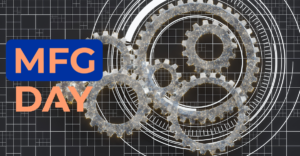Back in January, the editorial team at Manufacturing and Engineering Magazine (MEM) published an article with the headline, “If You Haven’t Automated and Added Robotics — It Might be Too Late.”[1] The article, however, never explains why it might be too late. The editorial team might have been thinking like entrepreneur Aaron Levie (@levie), Chief Executive Officer, Cofounder and Chairman at Box, who once stated, “Better to be too early and have to try again, than be too late and have to catch up.” Catching up is always a difficult challenge. The MEM team pulled the rug from under their headline when they concluded, “Industrial automation and robotics are influencing the global economy. The entry barriers to implementing automation are lower than ever — and thus, accessibility is enabled into all operational areas.” Automation, robotics, and other advanced technologies are often lumped together in an industrial setting under the rubric Industry 4.0 — shorthand for the Fourth Industrial Revolution. If you haven’t joined the revolution, you might have some catching up to do. But it can be done.
Industry 4.0 Technologies
The staff at i-Scoop writes, “Industry 4.0 is the information-intensive transformation of manufacturing (and related industries) in a connected environment of big data, people, processes, services, systems and IoT-enabled industrial assets with the generation, leverage and utilization of actionable data and information as a way and means to realize smart industry and ecosystems of industrial innovation and collaboration.”[2] They go on to note that nine technologies are generally considered essential to the Industry 4.0 movement. They are:
1. The Internet of Things. Sometimes referred to as the Industrial Internet of Things (IIoT), the IoT connects a network of machines and products. It provides multidirectional communications between networked objects. In reality, the IoT is an ecosystem consisting of sensors on the machine-end connected to advanced analytics platforms on the decision-making end. Some pundits discuss the importance of 5G technology in connecting a modern factory floor.
2. Big Data and Advanced Analytics. Industry 4.0 is a manifestation that the world has moved into the Digital Age — a world in which data is a company’s most valuable asset. Data generates the most value when it is analyzed and influences decision-making. More often than not, advanced analytics are embedded in some sort of cognitive technology (aka artificial intelligence (AI)) platform.
3. The Cloud. Because so much data is being gathered, analyzed, and shared, the cloud has become the place most organizations have selected to store that data.
4. Cybersecurity. Perhaps the greatest risk for Industry 4.0 manufacturers comes from breaches in cybersecurity. Because Industry 4.0 relies heavily on connectivity, ensuring that connections are secure is a high priority for any Industry 4.0 enterprise.
5. Automation and Advanced Robotics. The MEM team notes, “Automation, robotics, and related digital trends have expanded throughout manufacturing for some years and are on the rise more than ever before. By adopting innovations on the manufacturing floor, manufacturers have optimized many parts of their operations, including product quality, line efficiency, and worker safety, to name but a few.”
6. Simulation and Digital Twins. Simulations allow manufacturers to optimize their processes based on real-time data by leveraging cognitive technologies. Recently, digital twins — virtual models designed to reflect physical objects — have become a popular addition to the simulation family.
7. System Integration. Organizations work best when they are aligned. Manufacturers organized using Industrial Age principles often find that their data is siloed making alignment difficult. Cross-company data integration, data democratization, and company-wide collaboration enhances alignment and operational effectiveness.
8. Additive Manufacturing. Sometimes called 3D printing, additive manufacturing has created a new way of designing and producing products. Although additive manufacturing has limitations, it can reduce design time, create shorter supply chains, and foster new business models.
9. Augmented and Virtual Reality. Augmented reality — a technology that superimposes a computer-generated image on a user’s real-world view — can enhance training, improve maintenance, and accelerate logistics processes. As companies get more familiar with the so-called metaverse, they may also find new ways to use virtual reality.
The i-Scoop staff believes the next phase of Industry 4.0 (which some people are calling Industry 5.0) involves a new way of humans interacting with machines.[3] They conclude, ” The injection of AI, hyper-connectedness, and data analysis into how things … communicate, act and lead to actionable insights with an omnipresence of the Internet of Everything in virtually each piece/machine of the Industry 4.0 dream is one thing, the convergence of man and machine (or technological extension) is still a bit further away and it’s so complex and will lead to so many more debates (also ethical) that it’s already called the fourth platform by IDC.”
Beginning the Industry 4.0 Journey
Not every company will need to adopt all nine technologies mentioned above. The likelihood, however, is that most companies will need great connectivity, accessible data storage, cybersecurity, and cognitive technologies at the very least. At the same time, companies must not implement new technologies without a good reason. If you are just beginning your Industry 4.0 journey, supply chain expert Krasimir Hristov notes, “The potential gains for any production operation are significant, but there are also some requirements to be observed before attempting to implement Industry 4.0 practices in a manufacturing facility.”[4] His requirements include:
• Understanding manufacturing production issues you’re trying to address. Hristov notes, “Industry 4.0 is not a ‘magic wand’ that will solve all your company’s production problems in one go. It’s a combination of intelligent factories where various technologies work together on specific problems. Applying them to a situation properly starts with identifying specific problems.”
• Identifying specific solutions that can help address those issues. The next step, Hristov writes, is “go through current solutions that Industry 4.0 offers and figure out which of them can fit into your current situation. Once you know what specific problems you’re trying to solve, finding solutions for them should be relatively straightforward.”
• Creating a detailed plan. Keep in mind what the late Dwight D. Eisenhower’s said about planning: “In preparing for battle I have always found that plans are useless, but planning is indispensable.” Plans aren’t always useless; however, they must adapt as conditions change. Hristov writes, “Come up with a detailed plan of action, and identify potential problems along the way. Remember that this will be a complicated process that requires many different factors to align properly, and it will take a while to get things done right. Make sure that you know what to expect at every step of the way and try to have some backup ideas in case things don’t work out exactly as you anticipated.”
• Ensuring everyone in your company is on the same page. Centuries ago, Niccolo Machiavelli, in his classic The Prince, wrote, “There is nothing more difficult to take in hand, more perilous to conduct, or more uncertain in its success, than to take the lead in the introduction of a new order of things, because the innovator has for enemies all those who have done well under the old conditions, and lukewarm defenders in those who may do well under the new.” Anyone who is not on the same page with your plans is likely to be a saboteur (consciously or unconsciously) of progress. Hristov suggests getting people on board early with training and explanations. He writes, “People will need time to get used to doing things in a new way, and there will be issues and questions to resolve. The more time you set aside for that, the smoother the whole process will be.”
Concluding Thoughts
The editorial team at Design News writes, “Industry 4.0 organized assets on the shop floor and relieved much of the dirty and dangerous physical labor in the plant. Artificial intelligence is going further. These software systems are beginning to replace some of the human decision-making. The idea is that AI can make decisions based on far more data than a human brain can manage.”[5] At Enterra Solutions® we agree that cognitive platforms are going to be making more decisions in the future. As a result, we are focusing on advancing Autonomous Decision Science™ (ADS™) technology. Enterra ADS™ technology is the next wave of analytic innovation beyond data science. Our AI software leverages human-like reasoning to serve as a data scientist and subject matter expert. It analyzes data, understands business processes and logic, and makes decisions as accurately as the best expert.
The Industry 4.0 movement is over a decade old. That begs the question: If you are only beginning your Industry 4.0 journey, can you catch up with your competitors? The i-Scoop staff provides the answer. They write, “Even ten years after the ‘launch’ of Industry 4.0 we see that most enterprises are still in the quite early stages of their cyber-physical convergence efforts.” Get going. It’s not too late.
Footnotes
[1] Editorial Team, “If You Haven’t Automated and Added Robotics – It Might be Too Late,” Manufacturing and Engineering Magazine, 17 January 2022.
[2] Staff, “Industry 4.0 and the fourth industrial revolution explained,” i-Scoop, 2022.
[3] For more about Industry 5.0, see Stephen DeAngelis, “Are People Seriously Talking About a Fifth Industrial Revolution?” Enterra Insights, 19 April 2022.
[4] Krasimir Hristov, “Preparing Your Company for Industry 4.0!” Supply Chain Game Changer, 28 March 2022.
[5] Staff, “AI Takes Manufacturing Beyond Industry 4.0,” Design News, 14 February 2022.





